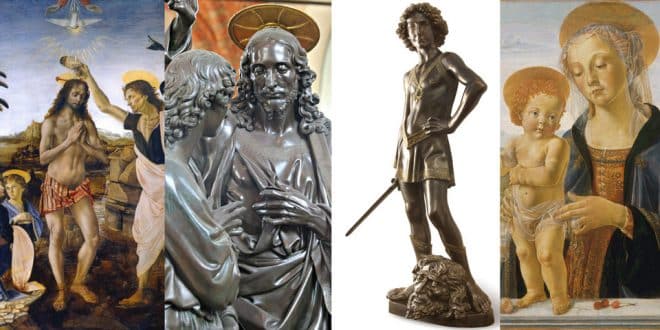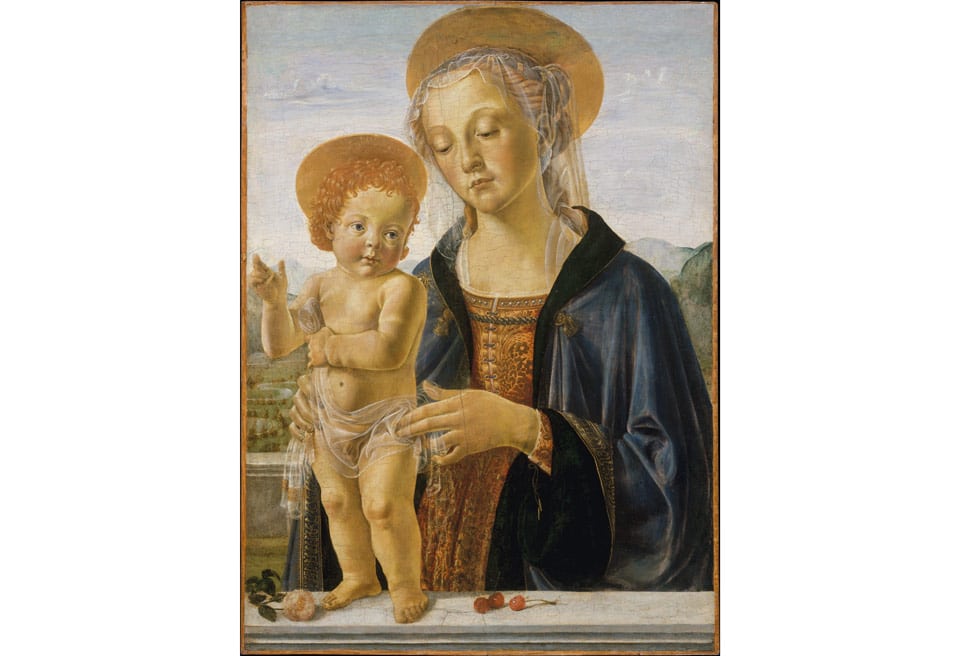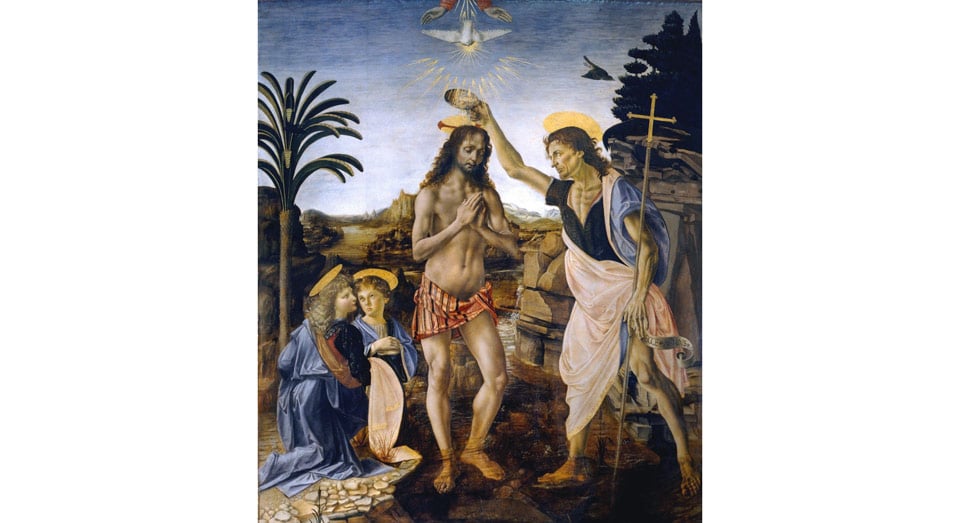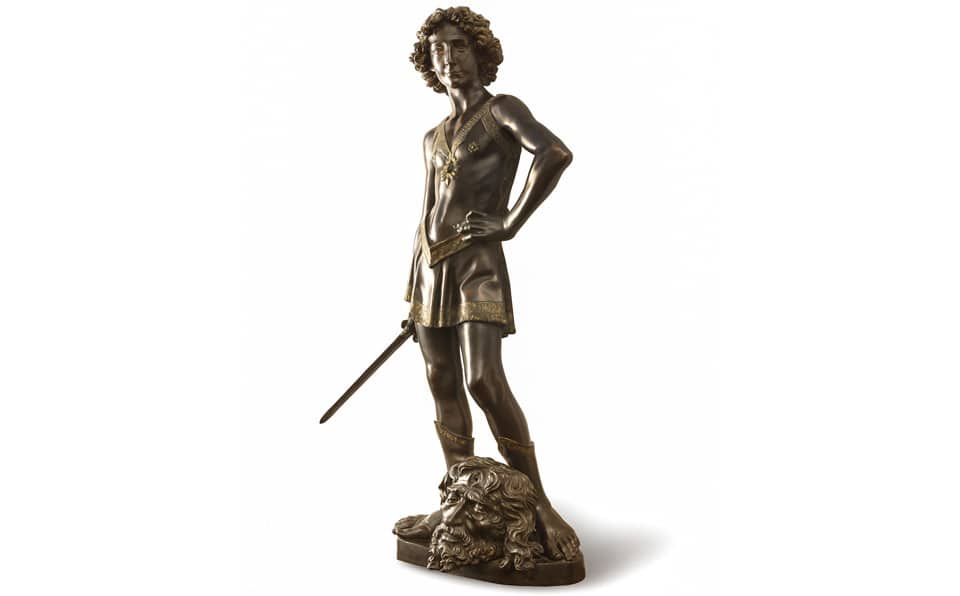Andrea del Verrocchio is a prominent figure, an outstanding Italian sculptor and painter of the Renaissance period, who has left a profound impact on world culture through his talent and inexhaustible hard work. His magnificent works have been recognized and admired by both contemporaries and future generations.
The paintings and sculptures created by the master are included in the collections of many museums in Italy and other countries around the world, captivating audiences with their exceptional execution and depth of conceptual ideas.
Page Contents
Biographical Information and Verrocchio’s Workshop
There is little information available about the personal life of Andrea del Verrocchio, whose real name was Andrea di Michele Cioni. It is known that he was born in Florence (Firenze) around 1435. In his childhood and youth, he had a passion for music, showed an inclination towards technical sciences, loved geometry, and astronomy. The family of the future master did not belong to a noble lineage, but thanks to his father, who worked as a craftsman and later served in the city’s customs, they did not experience significant financial hardship.
After the early death of the breadwinner, 17-year-old Andrea had to earn a living and provide for some of his brothers and sisters. However, his passion for art and the insatiable desire to create beautiful works determined the fate of the young man.
The artistic journey of young Andrea, like many famous artists and sculptors of the Renaissance, began with learning and working in one of the jewelry workshops in Florence. There, he engaged not only in the production of precious jewelry but also delved into the fundamentals of painting, sculpture, and architecture. His first teacher was Giuliano Verrocchi, whose surname Andrea adopted in a slightly modified form for his future pseudonym.
After several years, Andrea del Verrocchio established his own art workshop, which gained incredible popularity among the inhabitants of Florence. It became a source of diverse education and invaluable professional experience for a whole array of young aspiring artists and sculptors, who would become the titans of the Renaissance era. Among them were:
- Sandro Botticelli;
- Pietro Perugino;
- Domenico Ghirlandaio;
- Lorenzo di Credi;
- Leonardo da Vinci.
In the workshop of Verrocchio, there prevailed an atmosphere of infinite love for art, science, philosophy, and literature. In addition to studying traditional techniques of working with paint, metal, stone, plaster, and leather, special attention was given to precise disciplines and their practical application in painting and sculpture. Discussions flourished about the artistic value of various works, detailed debates on humanistic ideas took place, and discussions about classical heritage were held.
Verrocchio earned deep respect and patronage from influential citizens and patrons of Florence, receiving various commissions from them. The members of the Medici clan (Medici), who were the unofficial rulers of the republic at that time, showed particular interest in his creations. With great talent and resourcefulness, Verrocchio successfully decorated noble feasts and court festivities.
He spent most of his life living and creating in his hometown. Towards the end of the 15th century, he moved to Venice (Venezia), where he passed away at the age of 53 in 1488.
Sculptures and paintings – the master’s distinct style
In art circles, it is generally believed that Verrocchio turned to painting no earlier than the 1460s. The paintings he executed predominantly revolved around religious themes.
In the artist’s skillfully recreated evangelical narratives, a prominent place is occupied by depictions of the Madonna (usually with the infant Christ). In Verrocchio’s works, the Virgin Mary almost always appears as a sorrowful maiden, imbued with quiet melancholy and humility. A distinguishing feature of his style is the aristocratic refinement, meticulous rendering of details, precision and sharpness of drawing, as well as the spirituality and lyricism of the figures. It is noteworthy that not all paintings known as works by Verrocchio can be attributed to the Florentine artist with absolute certainty.
In his sculptural works, the influence of ancient art and the creative legacy of such brilliant artists as Donatello, Antonio del Pollaiolo, and Desiderio da Settignano is clearly evident. Verrocchio aspired to perfection of form and largely succeeded in achieving it. The sculptures of this artist, who was considered the foremost expert in metalwork in his time, exerted a significant influence on the development of bronze casting.
The Baptism of Christ
The painting “The Baptism of Christ” (Battesimo di Cristo) is recognized as the most famous work of the master, executed in collaboration with his student, the young Leonardo da Vinci, in the 1470s. The story is based on a canonical biblical scene from the Gospel of Matthew, which was frequently depicted by painters of that era.
In terms of composition, the characteristic features of medieval painting can be observed in the depiction of the central figure of the Savior standing in the waters of the Jordan River, as well as in the portrayal of John the Baptist. The characters lack individuality; rather, they serve as symbols representing majesty and deep spirituality. The movements appear constrained, lacking dynamism, and the poses seem somewhat artificial. The background, resembling a stage set rather than a landscape, lacks a sense of space and perspective. At the same time, the artwork is distinguished by a rich color palette and a variety of shades.
In the lower left corner of the painting, there is a figure of a small angel dressed in blue robes. This part of the work, executed not with tempera but with oil paints, was created by Leonardo da Vinci.
Until 1530, the painting was located in the San Salvi church in Florence, after which it was transported to the Uffizi Gallery (Galleria degli Uffizi), where it is exhibited to this day.
- I recommend booking a personal guide for a better understanding of the gallery’s exhibits.
David
The nearly one-meter-tall (125 cm) bronze statue of David, executed with incredible technical mastery, belongs to the 60s-70s of the 15th century. This sculptural work brought fame to Verrocchio and rightfully came to be regarded as the epitome of Renaissance sculpture. The influence of Donatello and his statue of the young naked king, a victorious warrior created several decades earlier, is clearly evident in the master’s work.
Verrocchio’s sculpture is distinguished by its elegance, aristocracy, expressiveness, and anatomical precision in depicting the human form. The biblical king, sculpted by the artist, appears as a courageous, triumphant youth, enjoying his victory over the defeated Goliath. His slender, beautiful body is clad in tightly fitting leather armor. The relaxed pose, a half-smile on the lips, and the turn of the head—each detail speaks of the hero’s profound satisfaction and self-assurance, while the severed, powerful head of the giant lying at the feet of the young warrior eloquently underscores the value of the won battle.
According to a legend, it was Leonardo da Vinci himself who posed for Verrocchio while working on the statue of David, but it is not possible to prove the authenticity of this claim.
The sculptural masterpiece was commissioned by the Medici family and was initially intended to adorn the Villa Careggi. Later, the statue was transferred to the Palazzo Vecchio, where the Florentine Signoria was located. In 1777, the master’s work found its place in the Uffizi Gallery. Currently, this magnificent sculpture by Verrocchio is housed in the treasure chambers of the National Bargello Museum.
I recommend reading about Michelangelo’s David as well.
Thomas’ Doubt
The monumental work Christ and Saint Thomas, also known in art circles as The Doubt (or Assurance) of Saint Thomas (Incredulita di san Tommaso), was created in the 60s-80s of the 15th century.
Originally, the sculptural group was installed in one of the 14 niches adorning the exterior walls of the Orsanmichele Church in Florence. It has now been replaced by a copy, while the original, which underwent extensive restoration at the end of the last century, is preserved within the walls of the museum bearing the same name, located near the church.
The figure of the Savior plays a dominant role, while the holy apostle stands to the left, extending beyond the niche. However, the unity of the descending lines of their garments, the spiritual gestures, and the profound dramatization on the faces of the characters create a sense of absolute artistic integrity and completeness in the artwork. Such a compositional solution in facade sculpture was a true innovation for the art of that era.
Read also about the Sculpture of Ancient Rome.
Interesting Facts about Andrea del Verrocchio
- Andrea del Verrocchio, born Andrea di Michele di Francesco de’ Cioni, was born around 1435 in Florence, Italy, and became one of the most renowned artists of the Italian Renaissance.
- Verrocchio’s workshop in Florence trained many notable artists, including Leonardo da Vinci, who became his apprentice and collaborator.
- Verrocchio’s most famous sculpture is the bronze “David” (1473-1475), known for its exquisite details and dynamic pose, which influenced future Renaissance sculptors.
- Apart from sculpture, Verrocchio was also a skilled painter. One of his notable works is “The Baptism of Christ” (c. 1475-1482), which features the young Leonardo da Vinci as the angel in the painting.
- Verrocchio was commissioned to create the equestrian monument of Bartolomeo Colleoni, a condottiero, or mercenary captain, in Venice. However, Verrocchio died before completing the sculpture, and it was finished by Alessandro Leopardi.
- Verrocchio was known for his mastery of various artistic techniques, including bronze casting, marble carving, and oil painting, showcasing his versatility and innovation.
- Verrocchio’s artistry and attention to detail, along with his ability to convey emotion and realism in his works, contributed to the development of the High Renaissance style and influenced future generations of artists.
 Italy for me From Italy with love
Italy for me From Italy with love





